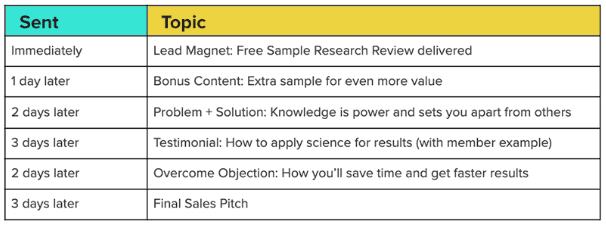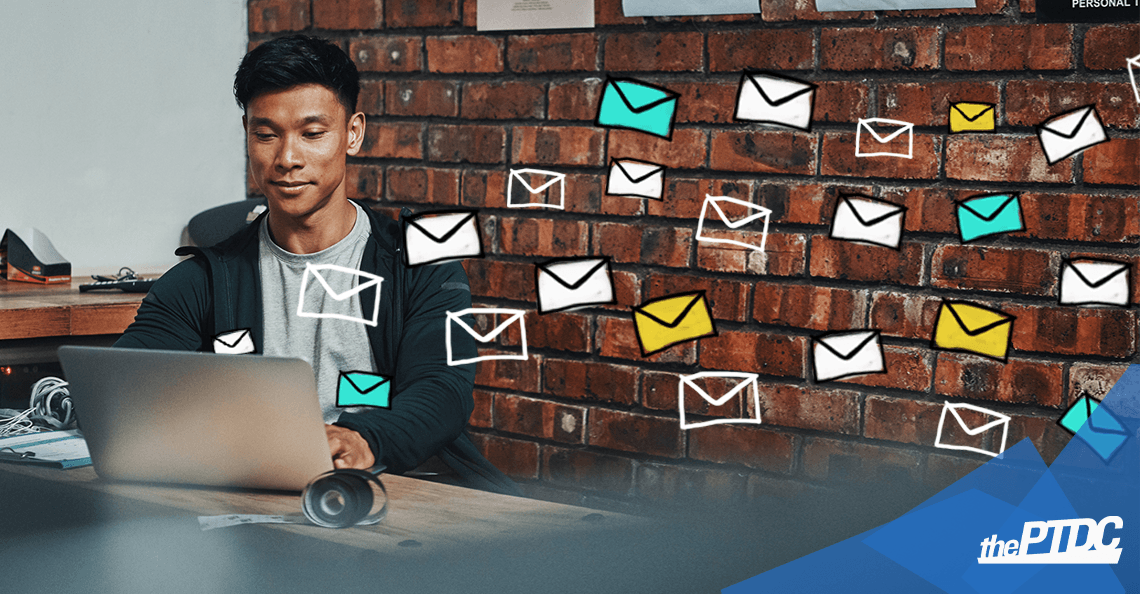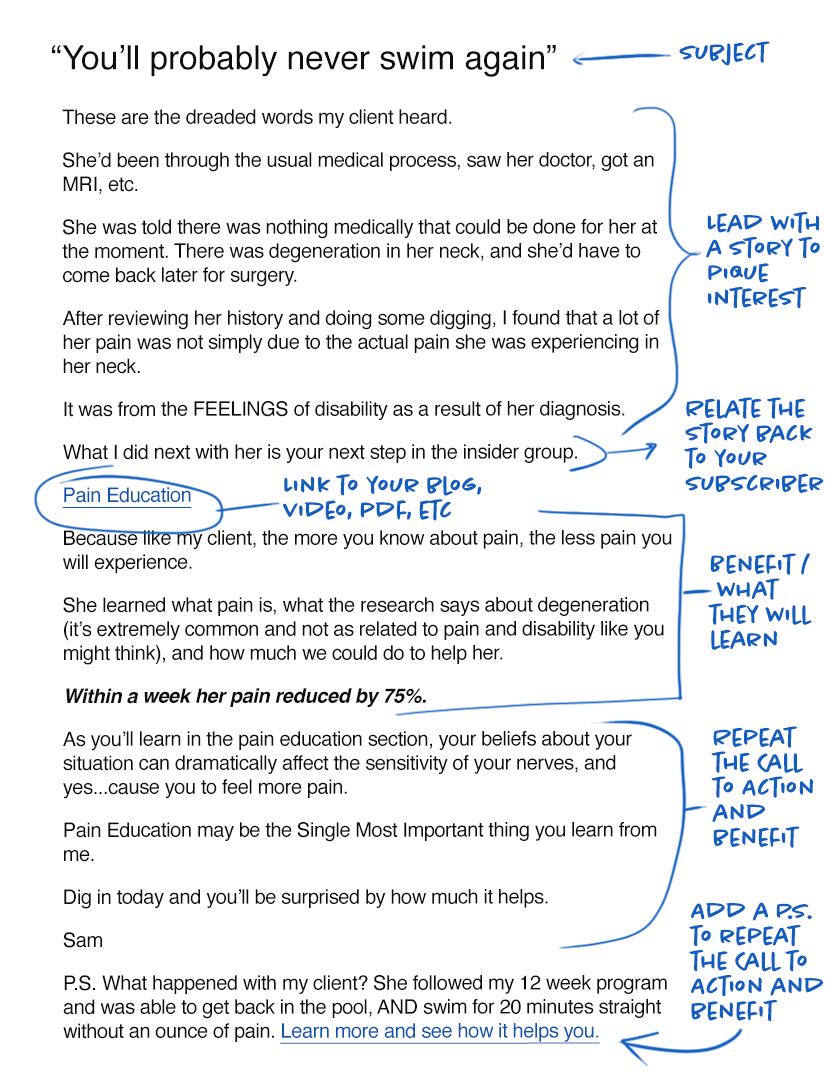The best digital platform for marketing your fitness or nutrition business is also the oldest.
Email lists were around long before Facebook, TikTok, or Clubhouse. They’re inexpensive to set up and maintain. Most of all, your list is yours, not Mark Zuckerberg’s.
Social media is vulnerable to disruption—one tweak to the algorithm can cut your organic reach dramatically.
But most people check their email before breakfast and at least once more before bedtime.
In fact, email marketing's return on investment is reported to be 42:1 on average—that's $42 for every $1 spent on email marketing—an impossible return with social media ads.
Getting started with email marketing is simple and straightforward. But it’s not easy.
The biggest challenge is overcoming the mental roadblocks:
- I don’t have enough content to add value.
- I don’t have a big enough following. I’ll wait until I’ve “made” it.
- I need a big email list to make it worth my time.
The good news is a small email list with potential buyers will bring you more success than a massive list full of random people.
I’m a perfect example. I have a small list because I serve a niche audience (fitness pros who want to master email). When I offered my first email marketing course for fitness professionals, I sent one email to 40 people—and immediately filled up my 10 spots.
Your success will be determined not by the size of your list, but by how you build it.
To build a quality email list, you have to develop a relationship with people. You do that with what I call the Three C’s:
Email marketing fundamental #1: Connection
The first step to building your email list: Giving your audience a reason to join it.
The best way to do this is with a lead magnet—a high-value freebie you offer in exchange for someone’s email address.
How to create a successful lead magnet
Step 1: Identify your audience’s single most common and frustrating problem.
What are your customers struggling with? What can you offer them that helps them overcome their problem?
The more your lead magnet addresses those struggles, the more appealing it will be to your target audience, and the faster your email list will grow with qualified leads.
Don’t overcomplicate it.
The most effective lead magnets are short and take your audience about 15 minutes to consume.
Try:
- a one-page worksheet or checklist,
- a three-part series of five-minute videos,
- or a three- to five-page pdf.
Give your lead magnet a nice cover to make it appealing and include a catchy title. This should take you no more than two to three hours.
Once you give your subscribers a quick win, at no charge, you become their go-to expert on the subject. They’ll be eager to learn more from you.
Some examples (note how specific they are):
Your audience’s problem: Fast-paced work schedules lead to poor nutrition choices.
Your solution: “Get my 5-step meal prep plan with grocery lists, including calories. You’ll have 6 meals cooked up in under 2 hours, eliminating the drive-thru temptation.”
-----
Your audience’s problem: They want to start lifting weights but feel intimidated.
Your solution: “Get my Beginner’s Guide to Lifting Weights with the #1 workout you need for results. It only takes 30 minutes, 2 times a week.”
-----
Your audience’s problem: They can’t stop snacking at night.
Your solution: “Late-night snacking ruining your progress? Get my 3 easy tricks to stop snacking before it starts, with a tracking chart for even more success.”
Step 2: Make your lead magnet actionable.
Put yourself in your subscriber’s shoes. If their goal is to firm up a saggy butt, which would be more appealing?
- A detailed analysis of the latest research on gluteal development
- The five best butt-shaping exercises to use in their next workout
Option 2 is the clear winner. Option 1 may be valuable to some, but to most it feels too much like homework.

Step 3: Align your lead magnet with what you’ll eventually sell to your subscribers.
It seems obvious, right? But you’d be surprised how many of my clients have said they wish somebody had told them this sooner.
Example: One of my clients is an online nutrition coach, but his lead magnet was a guide to doing push-ups.
Your lead magnet should start a conversation with people about what you sell now—usually your coaching service—or what you’ll offer in the future.
The four types of emails to send to your list
Now comes the hard part: giving your subscribers reasons to stay on your list.
You’ll do that with four types of emails …
- Point of view / In the news
A weekly email newsletter isn’t one-way communication. It’s a conversation, just like any other social platform. A high volume of replies is your reward for having an engaged audience.
You could offer your point of view on a controversial topic.
Or maybe you debunk a popular fitness myth, like how fasted workouts don’t burn more fat, or explain why a particular supplement is a waste of money.
The more you go against convention or challenge your subscribers’ beliefs, the more polarizing it will be.
It’s a risky move. If you do it poorly, you’ll needlessly antagonize some of your most loyal followers. Once they unsubscribe, you aren’t likely to get them back.
To do it well, you need to know what you’re talking about, back up your points with legit sources, and frame your message in a way that readers who disagree won’t see as a personal attack.
- Story emails
A good story email builds your relationship with subscribers by helping them get to know you. The better they know you, the easier it is to trust you.
Share something funny, inspiring, or encouraging. Make someone smile.
Your story can connect to a teachable moment, but it doesn’t have to. End with a question from time to time, asking subscribers to reply with their thoughts.
- Life updates
Did you move this year? Did something exciting happen with your business? Did your new puppy have diarrhea on the white carpet in your apartment (which, unfortunately, is a true story)?
These behind-the-scenes peeks into your personal and professional life help subscribers feel like they’re part of your world. It’s just like on social media. You can foster this sense of community with your emails, too.
- Teaching emails
These are the most common and offer the most value to your subscribers.
They can include stand-alone content—a list of tips, for example—or link to a blog post, video, or podcast episode.
Below is an example of a teaching email. Click here to download examples of all four email types.
Email marketing fundamental #2: Consistency
More and more, I see fitness pros start an email list with automation and funnels.
Think of it like this:
A new client tells you they haven’t trained since the second Bush administration, but they want to start with a five-day-a-week split routine.
No way, right? If they don’t get hurt within a week or two, they’ll burn out before they see any measurable results.
The same is true with your email list. Automation and funnels are the marketing equivalent of an advanced trainee’s body-part split. You’ll get overwhelmed if you don’t build a strong foundation first.
Start by writing a weekly newsletter, showing up for your subscribers consistently and reliably.
No, it’s not sexy. Neither is telling your client they should start with two or three simple workouts a week.
But advanced training makes no sense until you’ve mastered the basics. Same with advanced marketing.
Here’s why writing a consistent newsletter comes first:
- You’ll get more comfortable with the tool.
- Your writing gets better.
- You figure out what your audience wants from you.
Something else happens: You are remembered.
Fit pro Sam Forget is a bright spot in my inbox every week. He shares a ton of valuable health and fitness tips, gives his opinion on hot topics and sells his online nutrition coaching:

You can see I don’t read every email from him, but something powerful happens:
I see his name.
Just seeing his name and the subject line creates a connection and keeps him top of mind.
When your audience sees your name every week, you’ll be the fit pro they think of when they’re ready for the services you offer. You’ll be the one they buy from, even if someone else has a better product.
Email marketing fundamental #3: Commerce
Now it’s time to make money while you sleep. (Or while you unplug and load up the fam in your RV.)

Yes, it takes a while to get to this point. But it’s time well-spent.
You’ve put in the reps with your newsletter. You’ve got the right people on your list, people who know, like, and trust you.
You now have a rock-solid foundation to generate passive income with your products and services.
No matter what you choose to sell—the possibilities are endless—you should start with these three steps.
1. Build a sales sequence
My client James Krieger created a sales sequence to fuel sales for his Weightology Research Review.
Subscribers are enticed to join his email list with a free research review sample. (The review costs $15 a month.) Those who accept the free sample get a series of automated emails to convince them to become a member.
But the emails are more than a sales pitch. They explain why understanding research can help them deliver better results to their clients.

Krieger’s sales sequence doubled his sales from email in 2020—in the middle of the pandemic.
That’s the value of a good sales sequence. You only have to do the work once. Once the sequence is set up, it runs behind the scenes to generate revenue while you work on other parts of your business.
Need help writing your sales emails? This free downloadable worksheet breaks down how to write a problem-solution sales email to convert subscribers for your next cohort or course.
2. Create a launch list

My client Eat To Perform offers two memberships: monthly and lifetime.
Monthly is evergreen; anyone can sign up for it whenever they want. But they only offer the lifetime option a couple times a year, and the only people who can buy it are members who put their names on the launch list.
That process begins with an email invitation. Those who click the link in the email join the waitlist.
The last time they offered it, Eat To Perform sold out their available lifetime memberships within minutes, thanks to an unheard-of 30 percent conversion rate. (Two percent is a pretty good average for email promotions.)
A launch list strategy allows you to:
- See how much interest there is in your product before you try to sell it.
- Build a list of qualified leads, people who want you to sell to them.
- Develop a powerful sales email, one you can use over and over in future launches, tweaking and refining it if necessary.
3. Set up an upsell sequence
Most businesses focus most of their efforts on finding new customers. But for a fitness business, the real money is in selling to your existing clients and members—the people on your email list.
Once someone has bought from you, there’s an 80 percent chance they’ll buy from you again.
Example:
When I worked at Bowflex, we sold high-end home gym equipment. You would think the business lived or died with finding and converting new customers.
But our highest-performing marketing campaign was the “thank you” email we sent seconds after someone purchased one of our $3,000 machines.
After thanking the new customer, we said, “We noticed you didn’t get a mat for your new home gym. It’s the number-one accessory our customers love because it protects your floors and prevents your home gym from slipping.”
Then we gave them a coupon for 20 percent off the mat’s $99 retail price. We sold a lot of mats.
If you have a product or complementary service your clients can benefit from, set up an email sequence explaining why it helps them reach their goals. It works best when you offer a discounted price that’s exclusive to your customers.
When you get it right, it’s an easy way to generate passive income. Just make sure the products and services you sell offer a real benefit to your clients.













